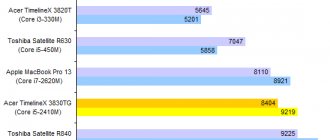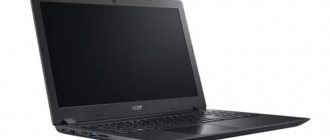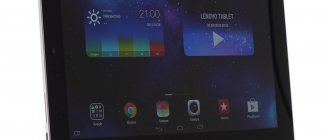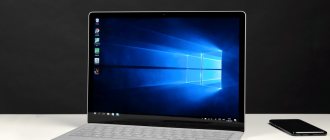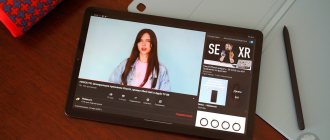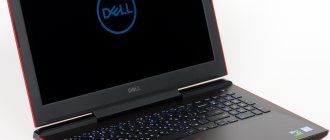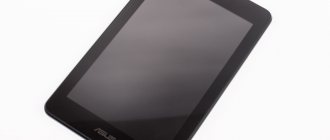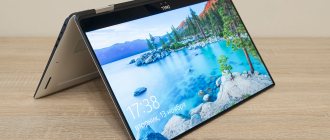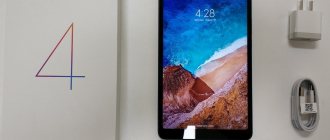For quite a long time I rushed from one mobile device to another in terms of the most convenient form factor, size, and weight. I tried different laptops and tablets, pairing one with another, etc. In the end, I came to the conclusion that I needed either a convertible laptop or a Windows tablet with a clip-on keyboard. In this case, the piece with the screen should weigh no more than a kilogram. So I bought a tablet with an i5 (albeit a mobile one), 8GB of RAM and a 256 gigabyte SSD. In general, I’ve already been using the tablet for a couple of years, but it’s still quite possible to buy it, and for quite decent money. It may go to a new owner one of these days (I bought myself a new device), but the machine is quite worthy and deserves a review. With pictures.
Purchase and delivery
I bought it on Ebay in the fall of 2014 for $600 including courier delivery (at that time it was something like 28 thousand rubles).
I bought it not new, but refurbished by the manufacturer (unfortunately, now there is neither that lot nor that seller), but there are enough offers for sale in the search. And it was cheaper than I paid for it - even in rubles, let’s not even talk about dollars. For example, ebay.com/itm/252395661438 - $300 with delivery. Good seller rating, fifty tablets sold... Although you can look at others, the main thing is that the tablet is Manufacturer Refurbished, and not Seller Refurbished. If you want, you can, of course, look for a new one, but it’s more expensive.
In Russia (at that time) for 30 thousand you could get a similar new tablet, but with i3, 4GB RAM and 128GB SSD. I decided to take a risk and get a more powerful one a little cheaper. Not without a problem (more about it below), but it was not a mistake.
Content
Design and features
Connection, performance, battery
Conclusion
In some ways, the Venue 11 Pro is a direct competitor to the Surface Pro. Our review unit had an Intel Atom processor and cost $499; in addition to this model, there are also options with Core i3 and Core i5 processors, prices for which go up to $849.
In everyday use, the Venue 11 Pro performs well and has some standout features, including an excellent build quality and an additional keyboard that is much better than the Surface keyboard. In addition, this device has a full HD screen with a resolution of 1,920×1,080, which is rare for gadgets with this screen size.
However, your $499 only covers the tablet itself; you'll have to shell out a whopping $160 more for the keyboard (but it comes with an extra battery, which softens the blow). And while it may seem crazy to pay $660 for an 11-inch Intel Atom tablet, the Venue 11 Pro is worth a chance.
Performance characteristics, equipment and appearance
The line is called Dell Venue 11 Pro, there are several models, mine is 7139.
Operating system:
Windows 8 Professional.
Personally, I find it more convenient for tablets than the 10, so I didn’t upgrade. I tried it a couple of times, but both times I rolled back. Processor
: Intel Core i5 4300U 1600 MHz (2 cores with hyperthreading, that is, 4 logical processors).
For me it was redundant, but there were no options with 8GB of memory and low-end processors. Built-in memory
: 256 GB, SSD (
replaceable
)
RAM
: 8 GB DDR3 1600 MHz (
soldered, so it won’t work to take a model with 4 gigabytes and then increase it
)
Memory card slot
: yes, microSDXC, up to 128 GB
(so neither I’ve never used it, I think) Screen
: 10.8″, 1920×1080 (IPS, glossy).
Video card
: Intel HD Graphics 4400
Wireless connection
: Wi-Fi 802.11ac, Miracast, Bluetooth 4.0, NFC
There are models with a built-in modem, I didn’t have one (I don’t need a modem in the tablet), but there is a place for installation and a slot for a SIM card. Cameras
: 8 MP, 2 MP
Sound
: yes, stereo
Ports
: USB 3.0, mini HDMI, 3.5 mm audio output, docking station connector
Battery capacity
: 36 Wh
Dimensions (LxWxD)
: 298x177x12 mm
Weight
: 797 g (
true
)
On the front there is a screen, a camera lens and a Start button below the screen. Glossy, yes. But prints are easily erased.
On the back is the camera, logo and body cover. We'll come back to it later.
On the left is a headphone jack, volume control, speaker grille, usb3 port.
On the right are the bulk of the connectors - miniHDMI, microUSB (charging only), a memory card slot under a flap, a lock mount, a speaker grille, a power button with an LED.
At the bottom - along the edges of the hole for mounting on the keyboard dock, closer to the center - connectors for communicating with the keyboard, in the center - a connector for connecting to the docking station.
On top there are ventilation grilles (one fan).
The equipment was simple - a tablet and a charger with an American plug.
I separately bought a stylus and a keyboard with a battery - already in Russia, because with the dance of the dollar at that time, it was easy to find old stocks in our country, which were slowed down as prices increased. The keyboard cost around 6-7 thousand, the stylus - 2 thousand. I later bought a used docking station on ebay for about 2000.
Keyboard (Mobile Keyboard Dock). In general, there are two options - a keyboard case and a keyboard dock. To turn the tablet into a normal laptop with the ability to work anywhere, I needed a dock. Plus an additional battery, which increases the operating time by one and a half to two times. The keyboard weighs 686 grams, together with the tablet it comes out to 1483 grams, almost one and a half kilos. It’s a bit heavy for an 11″ laptop, but I don’t always carry a keyboard with me.
I really like this layout - long backspace, flat enter and no additional buttons on the left shift. Fx is pressed through Fn, and multimedia keys are included there. The touchpad is small, but quite decent.
Place to mount a tablet. Metal tabs with latches, a button to release the tablet, connectors for connecting to the tablet and microUSB for charging the keyboard separately from the tablet. Occasionally, when the battery is completely discharged, it goes crazy and the tablet refuses to charge; then you have to connect the charger directly. In general, I prefer to charge from a tablet.
Below there are long rubberized legs.
The screen angle is fixed and small. But you can slightly finish it with a file (in the literal sense :)) and achieve large opening angles, 120-160 - depending on how much you want to file.
The mounts hold well and the tablet, when opened, can be easily dragged by any part, nothing will fall off. Unless you take it by the lower edge of the keyboard (where the touchpad is), the screen becomes overweight, a slight bend is obtained and spontaneous operation of the touchscreen and sometimes the buttons is observed. so it’s better to grab the screen itself or the keyboard closer to the screen.
The stylus is active, with its own battery (AAA). I don’t like them too much, but it is what it is. I used it very rarely - because for regular use the stylus must be stored inside the device. When I had a Samsung Note 8.0 tablet, I used the stylus much more often. The accuracy is good, the touch locks when you bring the stylus up.
Doc - I bought it on ebay, used one of the early revisions. I actually needed a second power supply, but the dock was sold for the same money along with the power supply, so I took it. Heavy - 825 grams, metal base. The case cover is plastic, soft-touch. The tablet connector rotates, the bottom support is rubber. Plus there is a rubber insert on the top support to prevent the body from scratching. Although all this rubber collects dust well and then does not release it. 
On the front there is a headphone and USB jack.
On the back there is power, two USB, network (gigabit), HDMI and DisplayPort. And dust.
Unfortunately, we were never able to get the video outputs to work; there was such a bug in early revisions. The tablet saw the connected device, wrote its name, but did not send the picture there. Therefore, I had to connect the monitor directly to the tablet.
Dock power supply. 19V, 2.31A, 45 watts. And without any microUSB.
Another accessory is the aforementioned keyboard case (Travel Keyboard, you can find thousands for three on ebay) and a couple of covers.
Design
The Dell Venue 11 Pro tablet looks like a guest from the past, this is exactly the design that was characteristic of the first Windows tablets - massive, thick and with active cooling. The contrast is clearly visible even against the background of modern models with OS from Microsoft, not to mention ultra-thin Android tablets. The overall dimensions of the model are 176.8 mm by 297.7 mm, thickness - 10.2 mm or 15.4 mm, depending on the modification, and the minimum weight is 771.5 grams and above.
The front panel of the device is completely covered with protective glass; the width of the bezel of the 11-inch screen is identical around the entire perimeter. A 2 MP webcam and a light sensor are integrated into its upper part, and a touch-sensitive Start button is integrated into the lower part, which responds to touch with a characteristic vibration.
The base of the case and the sides of the Dell Venue 11 Pro are made of practical, non-marking black plastic. The back cover differs from the rest of the case in that it has a soft-touch coating and can be easily removed using a small hole at the bottom. The motherboard and tablet components are hidden behind an additional casing, so that the useful things under the cover can be seen as a flat, removable 36 Wh battery. On the outer surface of the tablet cover there is a fingerprint scanner, an NFC module designation, as well as a manufacturer’s logo and a pair of service stickers. At the very top of the rear panel you can see the 8 MP main camera lens, as well as an optional smart card reader.
The sides of the tablet are literally filled with connectors and various functional elements; not a single edge is left free. Everything necessary for connecting with optional accessories is located below: a flat proprietary port, a pair of contact pads for charging the battery and two holes for mechanical fixation with docking stations and keyboards. The upper edge is occupied by openings for air intake and exhaust by an active cooling system, as well as a pair of digital microphones.
On the left side of the Dell Venue 11 Pro there is a combined audio port, a volume rocker, one of the stereo speakers and a full-size USB 3.0 connector. On the right side you can find a power button with an indicator of the battery charging process, a second speaker, a slot for MicroSD memory cards, as well as a micro-USB connector with the ability to recharge the battery and a mini-HDMI video output.
Entrails
I didn’t take it apart, but the back cover can be removed normally. Underneath you can see a 36Wh battery. Behind the metal cover is the processor (the cover cannot be removed without unscrewing the case).
Available expansion slots are in the upper right corner. There is an SSD, wifi is hidden behind a sticker, and there is a plug in the modem slot.
Purchase
Since sales of phones with WP7 in Russia have not yet begun, it was decided to order it from the USA. The ebaytoday.ru service was chosen as an intermediary for three reasons:
- It’s always more pleasant to communicate with Russian-speaking support, even if its quality sometimes leaves much to be desired
- This is not my first order through ebaytoday. The first one didn't go very well, the second one was much better.
- Taking into account the above, I wanted to test the work of their new warehouse, how much better it became.
After talking with ebaytoday technical support, it became known that the dell.com store does not work with intermediaries, so I had to order from Amazon. Previously, I only ordered from eBay, where everything was clear - seller, auction, bought - received, and from the B&N website, where everything is also clear - B&N is a seller, you pay him, he sends the goods. On Amazon, everything is far from so obvious - some products are sold by Amazon itself, some by other companies located on Amazon, and some are simply private traders. Who does the payment go to, from whom to demand the goods later if anything happens, who to call, etc. - unclear. In general, I decided not to tempt fate and entrust the professionals represented by ebaytoday to buy the goods for me, and at the same time check it in the warehouse for an additional fee.
As a result, the price of the phone for me turned out to be $394 - 349 per phone + commission of 34.9 + $10 verification. I topped up my ebaytoday account according to the scheme that I already described - first to a Qiwi wallet, and then through QIWI visa virtual and RBC Money to my ebaytoday account. The dollar exchange rate that day was good - 29.5 rubles, much better than 35 rubles during my first purchase. In total, I paid 11,622 rubles (+174 rubles commission, which will not happen if you pay with a card and not through QVC) to buy my phone.
The phone was purchased on Friday, August 5, and on Monday, August 8, it was in the ebaytoday warehouse (this is good, because my nooks, after they arrived at the warehouse along the track, could not be found for another day or two). They also said that the product had been checked at the warehouse, but for $10 they could have at least sent me a photo of my phone or something. Okay, let's write this down as a wish list.
The product was sent for packaging, which was surprisingly fast compared to the same Nooks - in about 4 hours versus 3 days. Next, I was invoiced for delivery - $47, which included filling out a customs declaration, additional packaging and insurance. It was not possible to pay for it right away - there was no time, so on August 9 the parcel lay packed in the warehouse, and on August 10 I deposited the required amount into the account (by the way, the dollar exchange rate changed and became 31 rubles - delivery already cost me 1,459 rubles). Less than an hour after payment, the phone was already sent to me - amazing efficiency, apparently the new warehouse has really changed the standards of ebaytoday.
The total cost of the phone was 13,276 rubles , which is approximately equal to the expected cost of the new xperia mini pro, which I was going to buy.
On August 10, the phone was sent to me, and on August 21 I received it in Kazan - the mail worked very quickly, I was lucky. For comparison, tracking of a parcel that was coming to me around the same days, but not from the USA to Russia, but from Azov to Kazan. It arrived in 13 days.
The phone came packed in a box full of strange things that looked and tasted like corn sticks.
Package with Dell Venue Pro
They spring well, so the box arrived completely intact.
Sound
This is where the aforementioned problem with the restored device lay.
The internal speakers did not work, they only clicked quietly if the volume was raised from zero. However, the headphones worked fine. The seller offered to exchange it, but I didn’t want to bother with sending it back, I don’t really need the sound in the tablet, and if necessary, it was quite possible to connect an external speaker or Bluetooth speaker. The seller also offered partial compensation, but we did not understand each other, we delayed communication, so I was left without compensation, and he was left with negative feedback. And after about six months of ownership, the tablet suddenly started talking and has been working without problems ever since.
⇡#Appearance and ease of use
Even with a meticulous external examination, the tablet does not betray its budget nature. The case is not record thin, but still 1.3 mm thinner than the same ASUS MEMO Pad HD 7. And its other geometric dimensions are smaller - while the display diagonal is a whole inch larger. Accordingly, the frame around the screen is narrower. There is none of the gloss that most budget devices sparkle with here. Of course, a shiny coating looks more interesting in pictures and on display, but in terms of practicality it is significantly inferior to a soft touch coating, which is more pleasant to the touch and is much less susceptible to scratches.
Due to the black color of the case, fingerprints are clearly visible on it, but the good news is that they are much easier to wipe off than from a glossy surface. The case attracts small fluff and dust to itself like a magnet - and getting rid of them is not at all so easy. Fortunately, they are not particularly noticeable. The build quality of the case is high: when you try to twist and squeeze it, although it gives in (the thickness of the device is still small), it does not make a single sound.
In front, above the screen, there is a front camera. From the rear, the main camera, highlighted with a silver edging, is accompanied by a large Dell logo made of “chromed” plastic and a more modest size Intel Inside logo, which will certainly attract the eyes of sophisticated users.
There is a speaker on the bottom edge of the case, a headphone jack, a built-in microphone, and a power button on the top. On the left are dual volume control buttons and a micro-USB connector. On the right side, under a flap, there is a slot for a MicroSD card. In versions with a cellular modem, there is also a slot for installing SIM cards underneath it.
Battery and charger
The charger here is unique. On the one hand, the tablet consumes quite a lot, and on the other hand, they made a microUSB connector for charging. That's why the charger is dual-standard. If the tablet is connected, then it produces 19V, 1.2A. And if something else, then 5B and 2A. Together with the keyboard, the tablet charges for about four hours, without the keyboard - about one and a half to two hours. If you try to charge the tablet from 5V 2A, it will charge for about a day. In ten hours I gained 50% charge.
The operating time was initially about five hours (Internet via Wi-Fi). With the keyboard it increased to about nine. After two years, the tablet itself works for 3.5-4 hours in Internet mode, with a keyboard - seven hours.
The fact that the charge is via micro USB seemed good at first. But, as it turned out, not for an i5 tablet. I wrote above about the charging speed from a regular power supply. But the tablet cannot work from such a charger; the battery runs out faster than the charge is carried out. So it would be better to make a regular round connector; you wouldn’t have to take aim every time you plug in the cable.
Dell Venue 7 3G review: anti-crisis compact Android tablet
Table of contents
- Introduction
- Specifications
- Packaging and equipment
- Appearance and design
- Display
- Software and firmware
- Hardware platform and performance
- Multimedia
- Wireless Interfaces and Communications
- File system
- Battery life
- Camera
- Comparison with competitors
- Conclusion
Introduction
There is no point in presenting Dell on our resource - I am sure that the vast majority of readers know about this giant first-hand.
For a long time, the company remained one of the largest manufacturers in the PC segment, but the market turned out to be much more dynamic than large players such as IBM, HP and Dell expected. Personal computers in the consumer segment are rapidly losing their positions (in fact, this is one of the reasons why you are reading this text), which inexorably dictates new rules of the game even for such market veterans.
And even the most conservative manufacturers now cannot stay away from the production of mobile devices, otherwise their profits may be significantly lower than in the “good old days.”
So Dell decided to enter the tablet market with the Venue series, in which the model index denotes its diagonal, and the Pro prefix denotes the use of Windows as an operating system. And, as you can guess, we will next talk about a seven-inch tablet based on Android.
announcements and advertising
2080 Super Gigabyte Gaming OC for 60 rubles.
Compeo.ru - the right comp store without any tricks
RTX 2060 becomes cheaper before the arrival of 3xxx
Ryzen 4000
series included in computers already in Citylink
The price of MSI RTX 2070 has collapsed after the announcement of RTX 3xxx
Core i9 10 series is half the price of the same 9 series
The price of memory has been halved in Regard - it’s more expensive everywhere
An interesting fact is that gadgets of American origin have nothing in common with those devices that are sold in the CIS countries and Asia, sanctions and all that. It must be said that at the moment things are not going so smoothly for the manufacturer in the mobile segment - “American” tablets cannot be called popular even with the best will in the world.
Let's figure out what's wrong with them, since they are so reluctant to buy them, despite their big name.
Dell Venue 7 3G Specifications
| Device type | Tablet |
| Model | Dell Venue 7 3730 |
| CPU | Intel Atom Z2580 (2 x 1600 MHz), x86 |
| Video processor | PowerVR SGX544 MP2 |
| operating system | Android 4.3 (updated to 4.4) |
| RAM, GB | 2 (DDR2) |
| Internal memory, GB | 8/16 |
| Screen | 7.0" IPS, 1280 x 800 (HD) |
| Cameras, Mpix | 3.0 + 0.3 |
| Net | — |
| Number of SIM cards, pcs. | 1*/0 |
| MicroSD support | Eat |
| Data transfer | GPRS, Wi-Fi (b/g/n), BT, 3G* |
| GPS/aGPS/GLONASS | Yes/Is/Is |
| Battery | 4 100 |
| Dimensions, mm | 193.0 x 118.0 x 10.0 |
| Weight, g | 320 |
| price, rub. | ~6500**/7500 |
*For version with SIM card.
**8 GB model without 3G module. The characteristics are not at all impressive if you look at the calendar. However, you can be glad for the presence of two gigabytes of RAM, although not the fastest. But the cameras and battery could be better.
On the other hand, the price is more than affordable, especially considering the economic situation.
Packaging and equipment Dell Venue 7 3G
The packaging is quite nice, it consists of a cardboard box and a dust jacket.
Unlike “indigenous” Chinese devices, the back side is not completely occupied by listing the technical characteristics. All inscriptions are translated with high quality.
One of the ends is decorated with legal information and a product sticker.
A huge sticker on the back indicates that this copy was intended specifically for Russia. Unfortunately, the low prevalence of this model did not allow us to find any reliable information about the quality of work of the warranty department.
Under the dust jacket is unpainted thick cardboard, which is often found among the packaging of budget models of smartphones and tablets from other manufacturers.
Inside, everything is spartan: no soft “beds”, foam rubber or soft filling.
The delivery package is not too pleasing either. It consists of the following accessories:
- MicroUSB cable;
- Charger;
- Documentation and warranty card.
You can't expect more in the budget segment.
The charger is very typical. We saw a similar (but not identical) model in the Lenovo A859 review.
Appearance and design of Dell Venue 7 3G
The first thing I noticed when I picked up the tablet was its weight. For a seven-inch device, 320g is a serious amount. It seems that under the back cover it has a 6,000 mAh battery, no less.
In terms of design, the Dell Venue 7 3G does not attract attention in any way. The only color available is black.
The back cover material is soft-touch plastic, which protects the surface well from fingerprints and improves grip, but over time it can begin to wear off.
The logo on the reverse side is made to look like chrome.
The location of the physical buttons is non-standard: the volume rocker is on the left, next to it is the charging port. On the right side you can see a flap that covers the memory card slot and SIM card.
The screen lock button is at the top and is optimized for right-handed use, so left-handers may find it awkward. At the top there is an AUX output and, presumably, a microphone for the noise reduction system.
The bezels around the display look slightly larger than we would like. Navigation buttons are part of the screen.
There is no earpiece, but there is a front camera with a dual lens. We have already observed this scheme recently, and, apparently, this approach does not provide any visible advantages.
It's not very clear in the photo, but there is a light sensor on the right that works flawlessly. But there is no LED event indicator.
If we look under a large lens with bright scarlet coating, we will find a very small lens with a different type of coating. Not bad for 0.3 megapixels.
The rear camera is not very rich; there is not even a flash.
In terms of optics, there are no surprises here; we have a standard lens with typical coating.
It's sad, but the chrome trim serves only an aesthetic function. It won't save you from scratches.
The design of the case, in my opinion, is extremely successful, despite the fact that it will not be possible to disassemble it without a screwdriver. The back cover is completely devoid of seams, and therefore the case does not emit significant creaks or crunches, and the overall structural rigidity is high.
The volume keys have a short stroke and a clear click, but the lock button is not so lucky; its click is “blind”; it is not always possible to tactilely understand the first time whether a press has occurred or not.
It’s nice that the manufacturer provided the connectors with a plug; the issue of cleaning will not be too acute.
But the speaker was disappointing. We'll talk about its sound later, but I'd like to complain about the fact that there's only one and is recessed deep into the body now. For better audibility, you have to constantly substitute your hand or a foreign object for the reflection effect.
Software and Performance
I originally installed Windows 8, which I updated to 8.1. As I already said, I tried to update to ten a couple of times, but it didn’t work out - I didn’t like the changes in the interface, especially in the browser.
CPU
I won’t test it a lot, the performance is sufficient for me.
But in general, Dell went overboard here and set up paranoid defenses. Firstly, the processor should throttle when it heats up above 65 degrees. Secondly, power throttling is set to 6 watts (instead of the native 14 watts for the processor). Out of interest, I tried to remove both limits, but it didn’t give me anything. At idle (everyday work), the processor briefly raises the frequency to 2-2.2 gigahertz, but under a long-term 100% load, I did not see it exceed 1.3 gigahertz. But the temperature did not rise above 65 and it did not go into throttling. Although people on the forums write that they managed to squeeze out more. The fan is not loud and can only be annoying in complete silence. Processor information:
CINEBENCH R15 (there is no single core rating here, but in general it was around 73):
For comparison, a budget tablet based on atom z8300
And a laptop on Core M5:
Disk
There is a 256 gigabyte SSD. Sometimes I didn’t have enough of it (photos at the end of the vacation ate up the free space), I thought about changing it, but the toad was against it every time and said “erase anything unnecessary or throw the extra onto a flash drive.”
The default disk partition is that the system has been freshly restored and a bunch of updates have been installed. Surely you can free up another ten gigabytes, and if you go to ten, you’ll also destroy the recovery partition.
Disk performance test:
Games
Basically, I play all sorts of little things on my tablet, like 2D quests and visual novels - they run without problems. But for a wider audience I decided to try World of Tanks. SD client, minimum settings (without additional tweaks): FullHD - 15fps. 1366x768 is a fairly stable 30fps.
But for a wider audience I decided to try World of Tanks. SD client, minimum settings (without additional tweaks): FullHD - 15fps. 1366x768 is a fairly stable 30fps.
Performance
I will not present graphs and performance tests now, because these are not always objective indicators for a work computer, which in the vast majority of cases will not be used to the maximum of its capabilities.
Of course, the tablet copes with all office tasks with a bang and there are no problems with most programs (thanks to Windows for that).
However, there are several points in the software that left me perplexed. Initially, such tablets are designed so that people buy them and immediately sit down to work. It's not that simple here. First, you will have to go through the tedious registration of Windows, then it will take a lot of time to install a whole bunch of applications from Dell, most of which you are unlikely to ever use, and thirdly, MS Office is not installed here. Or rather, you will be offered to install it, but without the trial 30 days of use. “Take it or leave it!” - a popular phrase in the saloon of any Western, now sounds from the tablet.
One more thing. When watching videos on the Internet (we all do this from time to time at work), an interesting bug appeared: on Youtube everything is played without problems or stutters, but with other online players the device starts to heat up fiercely for some unknown reason. Moreover, when watching a 1080p movie downloaded from a torrent from the official online store, no heating was noticed. Mystery.
Conclusion
Advantages:
One of the few tablets with 8 gigabytes of RAM. For me this is a much more important parameter than processor power. Nice design. You wave the thing. Amenable to some upgrades and replacement of components without a file. Lots of accessories Full USB3 on the tablet itself.
Flaws:
The keyboard is a bit heavy Insufficient angle of the screen (can be cured by a little finishing) I would like to have one or two more USB on the keyboard, even if it’s 2.0 microUSB for charging Unknown sources of heating and, as a result, frequent operation of the fan.
And it’s not constant, but “howls and fades away.” It's not loud, of course, but it can be annoying at night. Almost the only reason why I wanted to change the device, the other shortcomings are not critical in my eyes. Moreover, after the decision to replace was made, the main candidate was the same 11 Pro, only the 7140 model was based on CoreM. It is without fans and sells for around 30 thousand on Ebay. But the future owner of 7139 only wanted it along with the entire “ecosystem”, so in addition to 30 thousand for 7140, another 10 would have been added for a new keyboard, etc. If not for this, then I would not change Dell with Lenova.
It is without fans and sells for around 30 thousand on Ebay. But the future owner of 7139 only wanted it along with the entire “ecosystem”, so in addition to 30 thousand for 7140, another 10 would have been added for a new keyboard, etc. If not for this, then I would not change Dell with Lenova.
In general, I recommend this option to those who want to have a Windows tablet-laptop with 8 gigabytes of memory for not too much money. It may be a little outdated and the cooling is active, but for the money it’s a good option. It can compete with the Chinese for the same price. Although Teclast X3 Pro can be considered as a worthy alternative - CoreM, 8Gb RAM, two full-fledged usb3... But it has its own characteristics, China after all. On the other hand, if you lower the requirements for the size of the RAM, then the choice greatly increases, both among the Chinese and among brands.
Ergonomics, accessories
Overall, the ergonomics of the Dell Venue 11 Pro tablet are not particularly different from other full-format Windows tablets. All the necessary controls are at the user’s fingertips, and a USB 3.0 port and a mini-HDMI video output are available for switching.
However, the most noticeable imprint on the ease of use of the Dell Venue 11 Pro is left by the very solid weight of the tablet and the presence of interesting branded accessories that turn this device into a stationary PC (docking station) or a full-fledged ultrabook (keyboard dock).
We were only able to take a closer look at the Dell Tablet Dock. Its massive base made of rubberized plastic is complemented by a gracefully curved metal stand that holds the tablet at the optimal angle from the point of view of developers. Switching is carried out using a proprietary connector, which made it possible to bring several connectors to the docking station at once: one USB 3.0 and a combined audio port in the front and three more USB 3.0, a network RJ45 and a full-size HDMI in the back.
Thus, by installing the Dell Venue 11 Pro on a stand and connecting a keyboard and mouse to the tablet, we get a convenient ecosystem for working in stationary conditions.
General impressions of the phone
Overall the phone is very fast. The responsiveness of the interface after Android is simply amazing - the animations do not slow down, everything is very beautiful and smooth. The metro ui interface itself is also very pleasant, the pivot and panorama controls are made very competently and are very convenient compared to classic “tabs”.
For quite a bit of money (13 thousand in my case) I got a well-built, stylish, fast phone. I think it’s worth it, and small little things like synchronization via zune can be put up with (people somehow live with iTunes, and at the same time pay twice as much for the phone!).
